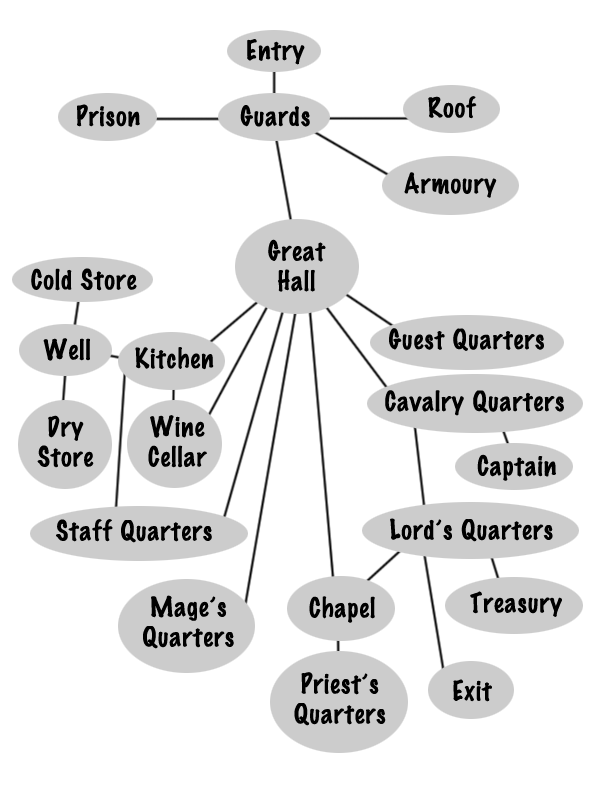A Rough Guide to Castle Design
Part 3 – The Floorplan
by Jon Roberts
To collect and transform the room list into a sensible layout I make a flowchart, finding this to be a simple way to list the areas and work out how they are connected or, indeed, isolated. You’re unlikely to get it right first time (the chart below is my third attempt) but that just goes to show that it’s time well spent. It’s much easier to fix a flowchart than a floorplan and lines added to a floorplan become an increasing deterrent to fixing mistakes.
Notice that there are already clear hubs. The great hall, the kitchen and a group connecting the Lord’s quarters, cavalry quarters and the chapel are all clear groups.
At this point we have the rough layout of our castle. Before we go any further, sit back and have a look at it. Think about anything else you’d like to add. In my case I want this to have a bit a twist. What if the castle is in a region that is beset by wyverns? To combat this, the castle needs covered walkways on the roof and battlements, and some means of combating the flying menace. I’ll add ballistas with alchemists fire from our wizard. I’m going to give our lord a gryphon too. This adds in an eyrie and solves the issue of how our lord might escape.
With these final twists laid in, I’ll do one final flowchart of the layout (below), now adding floors. This allows us to locate the stairs. If you’re feeling really keen you can always decide to place the fireplaces and chimneys here too. However, unless your players like turning into gaseous form and coming down the chimneys (mine do) you probably don’t need to worry too much about that level of detail.
Note that many of these groupings can be re-used in any castle. You can take the kitchen and stores and place them in a grand citadel, a hill giant’s lair or a mind flayer hive. I can re-use this castle structure for many situations with little chance of anyone noticing. Save yourself the hard work and re-use this work when you need to. If it makes sense in this castle, it’ll make sense in others too.
Now that the layout is set, it’s time to turn it into a map. You can dive straight into CC3 but I find it worth using pencil and paper to quickly sketch the floorplan first. This allows me to make sure that each floor’s area lines up and that the rooms fit. This does not need to be clean and beautiful. As this is for an audience, I have taken more care with my sketch than I normally would.
I use this step to ask myself:
- do my staircases line up?
- have I kept my connections in the right place?
- have I made sure that it’s hard to get to the most important places like the treasure room and the prison?
With this sketch to work from I know that when I create the pretty map I won’t have to go back in and fix things when something doesn’t line up right. I could use this to run an adventure, but I certainly won’t be using it as a battlemat.
 Back to Part 2 – The Room List >>
Back to Part 2 – The Room List >>


The flowcharts for laying out your structure is a terrific idea and one I’ll be using for many things. It’s so simple I can’t believe it never occurred to me.
Great article!
Great how-to series Jon. I especially like how useful it is for adapting layouts to protect against whatever nefarious magic/monsters/etc. might be roaming around the realm.
Just one observation on the residents. I didn’t see any women mentioned. Is the local lord married? If he isn’t, then he’d better be looking for a wife since ensuring the succession is a critical detail in this type of society. So, you need to include living quarters for the lady of the manor and at least a couple of ladies in waiting, and space for any kids she may have and caretakers for same.